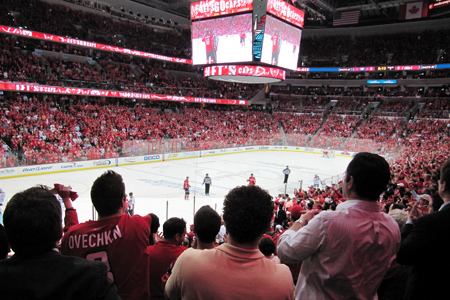Why Is Pro Hockey Beating the Bad Economy?

Garyisajoke/flickr
In the economic downturn, even professional sports are suffering. The NBA is facing labor strife and talking about shutting down unprofitable franchises. Baseball has seen some of its playoff games struggle to sell out. Even the seemingly healthy NFL is looking at a 2011 in which its players may go on strike if a new labor agreement isn't reached.
MORE ON HOCKEY:
Chris Good: Will the Olympics Save Professional Hockey?
Jake Simpson: For D.C. Hockey Fans, History Means Heartbreak
Chris Good: Hockey Fights vs. Baseball Fights: An Enforcer Dissects
Amidst all this gloom and doom, however, one sport seems to be doing better: hockey. The New York Times has noted how the NHL is showing "signs of growing strength," with more corporate sponsorship and rising TV revenue. Game six of last season's Stanley Cup final drew the highest U.S. audience for an ice hockey game in over 30 years.
A cynic might argue that in a deflationary age in which the value of everything is dropping, the professional sport at or near the bottom of the American sports pyramid has the least distance to fall, leaving it in the best shape. Others might credit hockey's relative financial stability to its association with Canada—a nation, after all, that has remained relatively unscathed by the global financial crisis since its banks experienced no foreclosure or subprime crises. And, as the Times notes, young telegenic stars and an Olympics last season that showcased the best of the sport haven't hurt either.
But since sports are culture (and vice versa), surely it goes beyond even these factors. Perhaps the sport's American renaissance began with Sarah Palin and her illustrious 2008 convention celebration of hockey moms, followed by two ceremonial faceoffs at NHL contests. If so, as with so much else, the contrast with Barack Obama—our first basketball president—couldn't be starker. In many ways the NHL is everything the NBA isn't. Basketball is played on urban playgrounds; hockey in rural or suburban rinks. If the NBA is locked at the hip to the swaggering, over-the top-bravado of ESPN and Le Bron, the NHL is the one major sport ESPN has largely ignored—which to some is a plus.
Perhaps most telling, hockey remains the last major professional sport that's virtually all white. This is not to suggest that hockey's current appeal is based on racism. Rather, it's that the game's racial makeup reflects what pro sports once looked like. By chance, this allows the sport to tap more easily into a common sentiment during hard times—an overwhelming nostalgia for a fabled "simpler" past. Watch the NBA and you're definitely not watching your father's game, if only because the basketball shorts of a prior era look way too small.
In contrast, ice hockey looks and sounds much the same as it did in the 1950's, albeit with a few central European names thrown in. The talk still seems mostly about the game—without steroids and players pulling out guns in the locker room.
In fact, the NHL has at times deliberately played to this longing for a less complicated sporting past. Recent innovations such as the Winter Classic, when the NHL plays its game outdoors, are deliberate throwbacks both to a simpler time and the game's roots—the latter the equivalent, perhaps, of the NBA staging a Knicks-Lakers game on a Watts or Harlem playground.
"Hard times have frequently inspired fond looks in the rear-view mirror," Stuart Elliott, the advertising reporter, wrote last year in a different context. Right now, no sport is heading forward into the past as successfully as hockey.